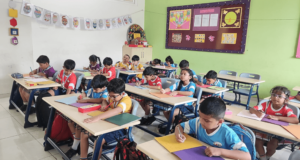Download our FREE Academic Calendar now! 📚 Start your child’s journey to success.
When you enter a school’s hallway for the first time for your child’s primary school admissions, you may see a common occurrence in every classroom – the presence of books everywhere! The reason behind it is not hard to determine. Reading is widely considered an integral part of a child’s development right from the Montessori stage up to the completion of primary education.
Encouraging reading is a part of a Montessori preschool’s overall values of emphasizing independence and satisfying the little children’s curiosity for knowledge. Montessori schools have rapidly gained in stature among the forward-looking parents across the globe. Their focus on an all-round development includes education, activities, and cognitive development in small children. They are gradually eased into the intriguing world of academics. And reading plays a vital role in this transition.
Here are some ways how Montessori preschools encourage the habit of reading in children:
1. Keep books within easy reach
Many classrooms have a lot of books in vivid hues, to attract the children’s attention. Pune schools have a lot of books lying around within easy reach of the children. Some classrooms prefer having an exclusive range of books in baskets nearby so that the baby student is encouraged to approach the place and pick a book that he/ she likes. For toddlers, they can access the books from a small shelf that they can access. Once the book and its storylines attract the child, he/she will be sure to keep up with reading habit on a frequent basis.
2. Associate reading with real-world scenarios
You can connect the details of reading materials with real life. For instance, if the book is about the universe, then ask the student questions about when they went to the planetarium and how the stars are similar to what he/she saw.
You can also do follow-up activities that can bring the story to real life. For instance, if the book references ice cream, then ask the kid to brainstorm fun ice-cream related scenarios, like flavors, asking parents for ice cream, sharing with siblings, etc.
3. Dig deeper into stories
It is always a great idea to engage the student with a story by asking questions about the character’s actions, feelings, and thoughts. The child is encouraged to connect the story through experiences at home or at school.
For example, for the poem ‘Twinkle Twinkle Little Star’, teachers can ask the students to count the stars when they are lying on the bed at night. They can then tell the teacher about the number of stars counted the previous night. Such instances will not only help the child find deep meaning in the story, but also enhance creative thinking.
4. Rotating the books at frequent intervals
The child’s interest in reading needs to be kept alive over the long-term. Hence it is vital that the books in the classroom are rotated on a regular basis. So even if the room has a lot of books, it makes sense to keep only two to four books out at any given time. Once the student has read these books, the teacher can rotate these and bring out other books. You may ask what is the ideal duration for rotating the books. Well, there is no ideal time, but many Montessori schools prefer changing the books once every two weeks or so.
This Montessori-inspired initiative will provide immense variety to the child. At the same time, it ensures that the child has access to only two to three books. Hence, he/she will not be overwhelmed with the huge number of books present overall. This child is sure to boost her vocabulary with this measure.
5. Give them the freedom to choose
Teachers may make the best choice in books appropriate for young children. But with the Montessori-inspired method, the child also has a greater say in choosing the books he/she wants to read. Such freedom of choice will keep the love of reading glowing warmly in the child’s heart. Let her pick one or two books of her choice. This way, teachers can also customize their picks based on the students’ frequent selection. Since the student now reads the book as per her choice, the level of involvement tends to be greater.
Remember that students may go through a phase where they don’t like reading. Who knows? The comic book she selects might just be the trigger needed to rekindle the love of reading? So it is wise to let the child pick the books she wants to read.
6. Provide a dedicated reading corner
Teachers in Montessori preschools are familiar with this part of the classroom – a dedicated reading nook. The corner needs to have a comfortable chair for the child to sit on. This nook needs to have adequate lighting to make reading an enjoyable experience. The entire ambience needs to come together to attract the little kid to come to the corner during the free period and read books. This is another step that can inculcate the good habit of reading in children.
7. Kids do what they see
It is a good idea for Montessori school teachers to spend time reading in front of the children. The students are bound to pick on this habit when they see their teachers (and their parents) reading books. When the child sees the teacher reading frequently, it is bound to pique her interest in reading as well.
For teachers too, this can be a worthwhile time away from smartphones, laptops and other electronic devices. Try it out today and see the remarkable difference made by reading.
To sign off
Technology is increasingly taking over precious development time for children. No matter how evolved our technology has become, reading still plays a crucial part in child development. So, it is important to encourage them to read more. Hence, these initiatives by Montessori preschools go a long way in attracting students to books and keeping them hooked.































